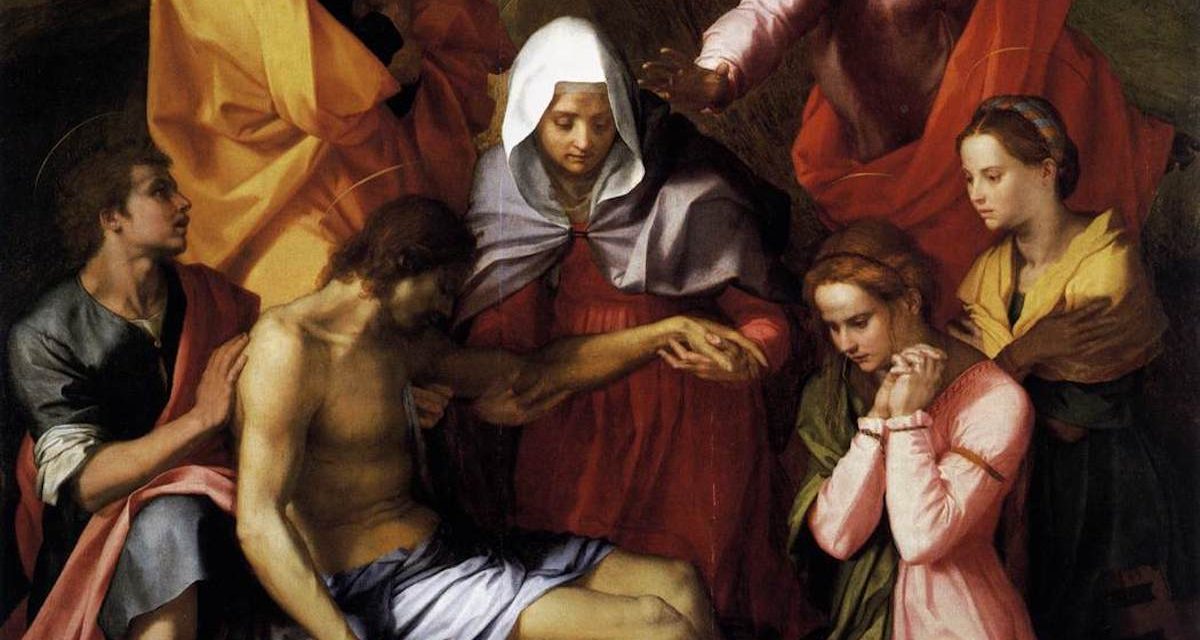In the darkness of suffering, there is a temptation to think that God no longer loves us, or that He is punishing us.
Every year on September 15, the day following the feast of the Exaltation of the Cross, we celebrate the memorial of Our Lady of Sorrows. We call to mind the sufferings endured by Our Lady throughout her life and, most importantly, at the foot of the Cross. To someone unfamiliar with the feast, perhaps it seems like an odd one. Are we celebrating her pain?
In a way, this goes hand-in-hand with one of the most prevalent criticisms of Catholic theology: Why do we talk about the Cross so much? Why don’t we focus on the Resurrection? Why is Jesus depicted in our churches on the Cross, when he has been risen?
There are some modern evangelists who try to preach the Gospel without speaking of suffering. They focus on the blessings that come from faith in Jesus. Yes, God wants us to be happy. He has promised us blessings and abundance of life if we are faithful. But that doesn’t mean we will never face suffering. To ignore that there is suffering in this life, or to teach that only riches and blessings will accompany our profession of faith, is to set us up for deep disappointment.
The False Gospel
A Gospel without suffering is a false Gospel.
This is the Gospel that Peter desired in Matthew 16:22. Jesus responds passionately, rejecting the path that doesn’t include the Cross. A Gospel without the Cross is not the Gospel of Christ. What does Paul remind us? “The word of the cross is folly to those who are perishing, but to us who are being saved it is the power of God” (1 Cor 1:18).
The feast of Our Lady of Sorrows is a feast our present world desperately needs. We live in a world that is suffering. You might have immense suffering in your life as you are reading this right now – dealing with a death or tragedy in your family, facing unemployment, rebuilding after natural disasters, battling cancer or another form of physical suffering, or struggling with depression or mental illness. If none of these things describe you right now, you surely know someone who is dealing with one or more of these crosses.
This feast reminds us that the “Good News” does not always remove suffering from our lives. In fact, it often seems to increase suffering! Remember the first reading a few weeks ago? The prophet Jeremiah was lamenting this very thing. “You duped me, O Lord, and I let myself be duped,” he complains (Jer 20:7). The Lord entered his life and called him to follow him, and nothing but pain and suffering and ridicule has resulted. But now that he knows the Lord and he loves Him, and he cannot help but speak of Him. The Gospel often brings suffering, but once we have fallen in love with Christ and the truth, we have to say with Peter, ‘to whom shall we go?” (John 6:68).
My Perfect Mother Suffered
As we celebrate this feast of Our Lady of Sorrows, we are reminded that even the holiest, most perfect woman to ever live suffered. Mary and Joseph traveled to Bethlehem while she was nine months pregnant. They had to flee to Egypt. She lost Jesus for three days. She witnessed the rejection of her Son for three years during his public ministry. Mary stood with courage and strength to witness her Son carry the cross and suffer the most brutal death imaginable–all because of our sins.
In fact, John Paul II tells us, “no one has experienced, to the same degree as the Mother of the crucified One, the mystery of the cross.” Since Mary is the only person in history who has completely and totally united herself with God, submitting to His holy will, holding nothing back, she’s the only one to truly understand what Christ’s sacrifice means. She enters into this mystery with her own fiat (“let it be done to me”), sacrificing her own heart. She experienced the horror of Cross- the manifestation of what sin does- with her pure heart that was unaffected by concupiscence. Our hearts have become desensitized. Her heart was fully sensitive and saw sin for the horror it was.
“Mary, then, is the one who has the deepest knowledge of the mystery of God’s mercy. She knows its price, she knows how great it is.” (John Paul II, Dives in Misericordia).
In the darkness of suffering, there is a temptation to think that God no longer loves us, or that He is punishing us. When we look at Our Lady, we can see that this is a lie in the darkness. God didn’t stop loving Mary. And He certainly wasn’t punishing her for anything she herself did. (Suffering is a result of sin, but our suffering is not always a result of our personal sins. Sometimes it is, when suffering directly results from my bad decisions. But other times God allows me to suffer for reasons I might not understand. See John 9:3.)
Suffering Has An Answer
We do not suffer alone. In his letter on suffering, John Paul II reminded us that through the Cross, Christ has entered every human suffering and can act within that suffering. In addition, from that Cross, he gave us His Mother:
“The Divine Redeemer wishes to penetrate the soul of every sufferer through the heart of his holy Mother, the first and the most exalted of all the redeemed. As though by a continuation of that motherhood which by the power of the Holy Spirit had given him life, the dying Christ conferred upon the ever Virgin Mary a new kind of motherhood—spiritual and universal—towards all human beings, so that every individual, during the pilgrimage of faith, might remain, together with her, closely united to him unto the Cross, and so that every form of suffering, given fresh life by the power of this Cross, should become no longer the weakness of man but the power of God” (John Paul II, Salvifici Doloris).
Suffering is an evil, a privation of the good. We don’t seek out suffering or desire pain. But we inevitably experience it in this valley of tears. Rather than preach a false Gospel that ignores the mystery of suffering, we look to the Cross – and the Woman standing underneath that Cross – to remind ourselves that suffering now has an answer.













